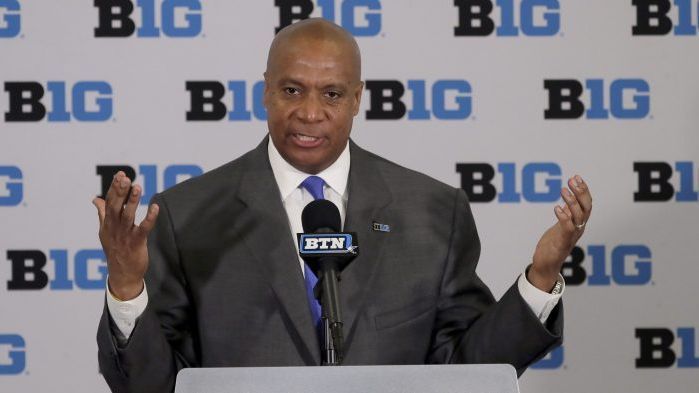Like many Big Ten fans, James Franklin spent the second Sunday in September frantically searching for good news.
The ACC and Big 12 had kicked off their seasons the day before, and now Franklin, the Penn State coach, was impatiently looking for an update from a meeting between the Big Ten’s medical subcommittee and the 14 presidents and chancellors who would make or break the chances of playing football this fall.
“I harassed Sandy with probably 45 text messages, phone calls, trying to figure out what’s going on,” he said of his athletic director, Sandy Barbour.
“His ’45’ was about 145,” Barbour joked.
Franklin’s fellow Big Ten coaches were similarly in the dark.
“Crickets,” one texted the night of Sept. 13.
“Nada!” texted another. “On pins and needles.”
Yet another coach texted a GIF from “The Sandlot,” with the famous line, “You’re killing me, Smalls.”
As Sunday dragged into Monday and Monday dragged into Tuesday without an official announcement, there remained a sense of cautious optimism.
Even after a month of tumult — protesting parents, sharp-tongued coaches and letter-writing politicians and attorneys who had piled on the pressure — the league presidents insisted they would not be swayed by anything but new medical information. Back on Aug. 11, the presidents voted 11-3 to postpone the season, so at least six presidents or chancellors had to change their votes to reach the 60 percent threshold for a fall season. And the entire council needed to know how the data and resources were different.
“For me, it wasn’t about political pressure, it wasn’t about money, it wasn’t about lawsuits and it wasn’t about what everybody else is doing,” said Northwestern president Morton Schapiro, chair of the Big Ten Council of Presidents and Chancellors (COP/C). “It was the unanimous opinion of our medical experts.”
Amid the backlash about the initial postponement, Big Ten commissioner Kevin Warren launched a task force to explore how the league could get back on the field. The conference formed subcommittees for scheduling and television, but the most significant group would assess the changing medical landscape around COVID-19. Co-chaired by Penn State’s Barbour and Dr. Jim Borchers, Ohio State’s lead team physician, the 16-member group included three other lead team physicians, four other athletic directors and leaders in sports medicine, infectious diseases and campus health.
The belief around the league was the committee had one final chance to convince the COP/C that a fall season was safe. Otherwise, Big Ten football would not be back until winter or spring.
Even after their presentation, Borchers didn’t know what to expect.
“I didn’t feel one way or the other about what their decision would be or even how quickly they would make it,” he said.
After a weekend of marathon meetings, the Big Ten presidents and chancellors voted unanimously that a fall season could take place. The league announced on Wednesday that a nine-game season would begin the weekend of Oct. 24.
Through exclusive interviews with Borchers and Barbour, along with conference sources and detailed accounts from university presidents, athletic directors, coaches and league officials, this is the story of the meetings that saved the Big Ten’s fall football season.
How the Big Ten got here
On Aug. 7, just two days after the Big Ten unveiled a 10-game, conference-only football schedule beginning Labor Day weekend, Warren met with the Big Ten’s medical advisory group. The doctors raised what Warren later called “serious medical concerns,” ranging from testing to contact tracing to potential cardiac issues. After consulting with the league’s sports medicine committee and the infectious diseases task force, Warren held multiple calls with the athletic directors, presidents and chancellors from Aug. 7 to Aug. 10.
As the COP/C mulled what to do, two presidents had views that would largely shape the final verdict: Michigan State’s Samuel Stanley, who has a medical degree from Harvard and a background in infectious diseases; and Michigan president Mark Schlissel, who earned his Ph.D. from Johns Hopkins and has a background in bioscience and immunology.
According to a source, Stanley and Schlissel “carried the day” as the Big Ten presidents met.
Stanley declined comment through a spokesperson, and Michigan did not immediately respond to an interview request for Schlissel.
By late afternoon Aug. 9, most Big Ten presidents and chancellors favored postponing the fall football season. The large majority felt that the next time Big Ten football could be played safely would be in 2021.
On Aug. 11, the COP/C convened again and voted to postpone the fall football season. The decision and the process around it triggered a backlash the Big Ten had never seen before. Coaches, athletic directors, players, parents, attorneys and politicians — from state leaders to President Donald Trump — voiced their displeasure and demanded that the league reverse course.
Warren told ESPN on Aug. 11 that the decision was based on science and the uncertainties that surrounded COVID-19. He cited “a whole litany of issues,” including a lack of uniform, daily testing throughout the conference; questions about contact tracing; an increase in caseloads nationally as teams were preparing for full-contact practices; and concerns about myocarditis, an inflammation of the heart muscle caused by viral infections that had shown up in several Big Ten athletes who had recovered from COVID-19.
“I’m not a physician,” Schapiro said. “When the medical team was divided, as they were five weeks ago, some people were convinced [the season could take place]. I wasn’t, as you know, from the vote.”
What needed to change
After the medical subcommittee formed, Borchers and Barbour received a list of concerns from the presidents. The list wasn’t prioritized, but each item would need to be addressed with concrete data and expert opinion.
While most items affected every Big Ten school, some were specific to a handful or even a specific campus. At Maryland, where athletic director Damon Evans and head team physician Dr. Yvette Rooks both served on the Big Ten’s medical subcommittee, the 2018 death of Terrapins offensive lineman Jordan McNair from heat stroke remained a painful reminder of the importance of proper protocols.
“I felt it was necessary for me to share that with my colleagues in the Big Ten, so that they would understand what we were dealing with,” Evans said. “All along, we at the University of Maryland, as much as we wanted to play football in all of our sports this year — they weren’t going to be played unless we felt comfortable that we were in a position, not only as an institution, but as a conference, to move forward in a safe manner.”
If the September decision was going to be any different, the medical information had to change too.
“It’s important that you are in a perpetual process of gathering information, analyzing information, setting high standards,” Warren said, “and also looking at each other to say that we have now met those standards for our student-athletes to participate.”
The Sept. 12 meeting marked the third time the medical subcommittee presented to the group of eight presidents and chancellors. Barbour said the steering committee was formed to provide guidance and give feedback. The first time they met, Barbour said the members of her group worked their “tails off” and thought they had the answers “before we really had them.”
The steering committee wasn’t sold yet.
“There were a number of things, some bigger than others,” Barbour said. “I think really nailing down what the parameters would be around both the testing positivity rate [players only] and the population positivity rate [players, coaches, essential staff], that was really important. And then the second was more about the evolution of the testing. In that time frame, it was changing every day.
“They wanted a more specific recommendation.”
In a lengthy but cordial meeting on Sept. 12, the medical subcommittee cleared its first hurdle with a presentation that outlined at least four rapid-response antigen testing options that would create daily, conferencewide testing and significantly decrease the need for contact tracing. The second component that further influenced the steering committee was a detailed plan to mitigate concerns surrounding myocarditis.
“Bigger picture, we had to give these presidents and chancellors a real solid way to save face on a reversal,” a source said.
The subcommittee presented protocols that would require Big Ten athletes to miss at least 21 days following a COVID-19 positive diagnosis. Those with COVID-19 would go through a comprehensive cardiac screening that requires clearance from a university-appointed cardiologist before returning to competition. The Big Ten would create a cardiac registry used to study the effects of COVID-19 on athletes. The medical subcommittee recommended each school appoint a “Chief Infection Officer” to oversee the collection of testing data, which would be broken into color-coded categories — green, orange and red — to guide programs in their decisions about practices and games.
The most important elements of the presentation involved rapid testing, which had seen advances in technology and accessibility since the Big Ten’s initial postponement.
“You’re catching somebody with a positive before they’re even contagious,” said Dr. Jeff Mjaanes, Northwestern’s head team physician and a member of the Big Ten’s medical subcommittee. “That’s a huge breakthrough in this. If we can do that on a daily basis, which is what’s in our proposal, then we can identify people before they’re even infectious, and we can remove them and really maintain the sanctity and the health of the team.
“With daily antigen testing, if you’re able to identify somebody before they’re actually contagious, and we can remove them, it almost completely eliminates the need for contact tracing.”
Nebraska chancellor Ronnie Green was among the three Big Ten board members who in August voted to proceed with the season (Ohio State president Kristina Johnson and Iowa president Bruce Harreld were the others, according to sources). Green believed all along that football could be played safely, but he also noticed the testing advancements since the postponement.
“Knowing what we know today about point-of-care antigen tests is considerably more than we knew going into early August,” Green said Wednesday. “That is something that has changed dramatically for us.”
Mjaanes said the Big Ten also was able to “secure some workarounds” so that every school could have access to cardiac MRIs. Penn State, for example, formed a partnership with Penn State Health Milton S. Hershey Medical Center so that any athletes who test positive will drive the 90 minutes to Hershey, Pennsylvania, for their cardiac tests. Heading into the Aug. 11 vote, a few Big Ten schools couldn’t easily process cardiac MRIs, which are key in detecting myocarditis and other heart issues.
“That was the other game-changer,” Mjaanes said.
Borchers said the medical subcommittee entered Saturday’s meeting “unanimous” in believing that its plan “would allow us to have a path forward.” Still, it tried to anticipate any additional questions the eight presidents and chancellors might have.
“You want to be confident in what you’re presenting,” said Borchers, a former long-snapper for the Buckeyes who became the athletic department’s lead doctor in 2016. “You want to make certain, just like with anything, that we’ve done our due diligence and examined everything we needed to examine. You want to revisit what your recommendations are, and you want to make certain you can communicate it clearly and be prepared to answer the questions that will come. Our subcommittee and sports medicine committee put in a lot of work to make certain we were able to do that.”
There also were discussions about how the fall football season would affect entire university communities. Borchers said one of the Big Ten’s principles in starting competition was a plan that didn’t take testing or resources away from those in need.
As of Sept. 15, Wisconsin had 2,160 students who had tested positive, according to The Washington Post, and all classes were being held virtually. At Michigan State, local authorities required students in 30 large residences to quarantine for two weeks because of a dramatic spike in cases. At Northwestern, freshmen and sophomores aren’t allowed on campus because of the virus.
“I did grapple with that, thinking, ‘Part of the campus is closed, and maybe you should just as soon play football when the campus is open, we hope, for the winter quarter at Northwestern,'” Schapiro said.
The Sept. 13 presentation to the entire COP/C lasted about 2½ hours, concluding in the late afternoon. Borchers made sure the subcommittee “didn’t leave any stones unturned” and answered every question from the presidents and chancellors.
There would be no vote. A source said half the league was wondering how Michigan State’s president, Stanley, would respond.
“We gave them the information that they needed to deliberate on and to consider,” Borchers said. “I thought we did it effectively and successfully. I felt that we did our work.”
1:07
Michigan head coach Jim Harbaugh says the Wolverines need to stay diligent in order to avoid any positive COVID-19 tests during their season.
‘The facts change, our minds change’
While the college football world waited for an official decision, the Big Ten remained mostly silent. Behind the scenes, Warren communicated with the COP/C, the Big Ten’s broadcast partners and testing companies (an agreement hasn’t been announced by the league). Although Warren had led the formation of the task force and remained involved in the steps leading to the resumption of competition, he “took a step back,” according to sources, and let the subcommittees present their case.
Sept. 14 came and went without much news, other than Wisconsin chancellor Rebecca Blank saying that whatever the league decided would be done in unison. (Reports had stated that some Big Ten schools might opt out of a fall season.) An answer appeared imminent Sept. 15 as a hot mic caught University of Nebraska system president Ted Carter saying that an announcement would come later that day. It did not.
The long-awaited vote occurred sometime between the afternoon of Sept. 15 and the following morning. Thirty-seven days after the postponement, the Big Ten announced a fall season was back on with the enhanced medical protocols outlined by the subcommittee.
In announcing the decision, Warren held a virtual news conference alongside Schapiro, Borchers, Barbour and two other ADs: Wisconsin’s Barry Alvarez (chair of the scheduling subcommittee) and Northwestern’s Jim Phillips (chair of the TV subcommittee). When the Big Ten originally postponed, Warren was the only person who spoke — and only to a handful of outlets.
“He let Barry run the schedule, he let Jimmy run with the TV, he let Jim and I run with the medical,” Barbour said. “Then he was the one who took the information to the presidents and chancellors; they’re his bosses.”
“There is no playbook for navigating COVID-19,” Warren wrote in an email Monday to ESPN. “I am very confident in the leaders that we have — from the Council of Chancellors and Presidents to our athletics directors, coaches and university administrators. I deeply appreciate our passionate student-athletes, their parents and our loyal and dedicated Big Ten fans and alumni. I believe that we will look back at this time and be proud that we put our student-athletes health and safety first and that we came out stronger and more united as a conference.”
The week before the medical presentation, Schapiro, the Northwestern president, was not convinced about moving forward with a fall season. After hearing the arguments, he saw “no reason not to go ahead.”
“Medical opinion changed,” Schapiro said. “Paul Samuelson, the great economist, was once asked why he changed his mind, and he said, ‘When the facts change, my mind changes.’ Doesn’t the same thing happen for you? The facts change, our minds change.”


